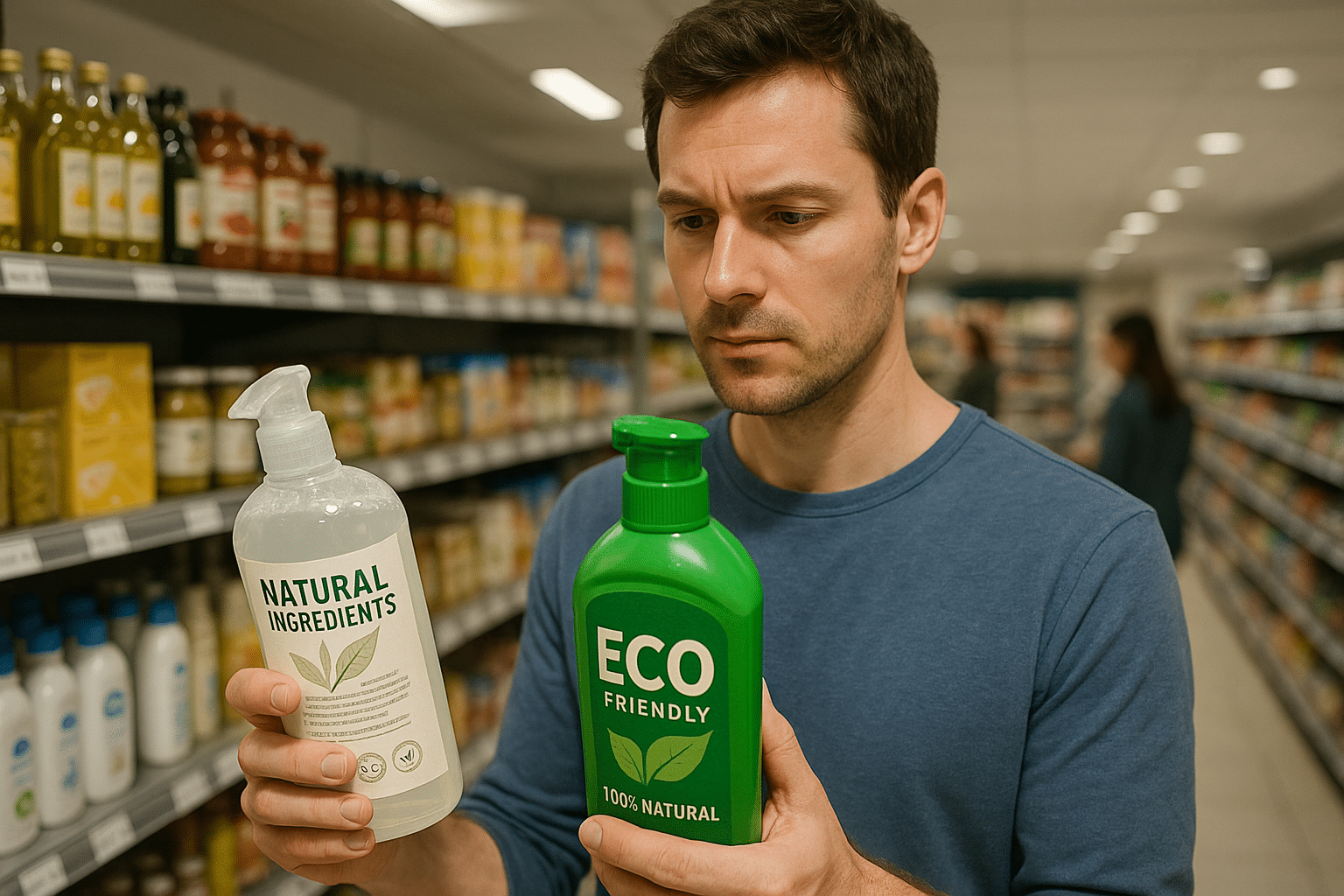This complexity increases in the age of ‘greenwashing,’ where companies often mislead consumers by presenting their products or services as more eco-friendly than they actually are. 🌍
So, how do we decode the truth? How do we ensure the products we choose are truly sustainable and that we are not victims of greenwashing? Unveiling the truth in this context is not just a necessity; it’s an imperative for all conscientious consumers and companies committed to genuine sustainability. This article aims to guide you on this journey. 💡
First, we will explore the concept of ‘greenwashing,’ its origins, why it’s problematic, and how it’s currently employed in various sectors. From there, we’ll delve into the principles of product transparency, providing you with concrete steps on how to identify truly sustainable products and services. Along the way, we’ll highlight some exemplary businesses that are leading the way in this domain, and we’ll discuss how their approaches could be replicated. 🚀
As an engineer and a technical writer with a focus on sustainability, my objective is to equip you with the knowledge and tools necessary to make informed decisions, both as consumers and as contributors to the market. The task is not easy; it requires critical thinking, in-depth research, and a commitment to sustainable practices. But rest assured, the effort is worth it, for both our planet and future generations. 🌳
In the age of information, we are surrounded by data. The challenge is to distinguish between what is genuine and what is not. This is particularly true when it comes to sustainability claims. The proliferation of ‘green’ labels and certifications can be confusing, and often, they are used as a smokescreen to hide unsustainable practices. 🌫️
But there’s hope. As we will see, numerous resources and guidelines can help us navigate this complex landscape. By understanding the language of sustainability, by knowing what to look for and what questions to ask, we can cut through the fog of greenwashing and make choices that are truly beneficial for our environment. 🌈
It’s crucial to remember that the pursuit of product transparency is not just a matter of personal choice; it’s a collective responsibility. As consumers, we have the power to influence businesses and drive change through our purchasing decisions. As businesses, we have the obligation to be honest and transparent about our practices. Together, we can make a difference. 💪
So, whether you’re a consumer wanting to make more sustainable choices, a business owner looking to align your practices with genuine sustainability, or just someone interested in understanding the ins and outs of greenwashing and product transparency, this article is for you. Let’s embark on this journey together, and let’s unveil the truth behind product transparency in the age of greenwashing. 🌟
Unmasking Greenwashing: Decoding Product Transparency
💡 In the era of information overload, making well-informed decisions about the products we consume can be overwhelming. More so when companies leverage the green trend, claiming their products to be ‘eco-friendly,’ ‘sustainable,’ or ‘green.’ Unfortunately, not all these claims are truthful, leading us into the murky waters of greenwashing. But fear not, this comprehensive guide will help you navigate the world of product transparency and identify greenwashing tactics.
As consumers are becoming increasingly conscious about their impact on the environment, they demand products that reflect their values. This demand has led to a surge in ‘green’ products. However, not every product labeled green is truly eco-friendly. This phenomenon is called ‘greenwashing,’ a deceptive marketing practice where companies misrepresent their products or services as environmentally friendly when they are not.
But how can you, as a consumer, see through this illusion? The key lies in product transparency. This article will equip you with the knowledge to navigate through product transparency and unveil the truth behind greenwashing.
Understanding Greenwashing
Before diving into product transparency, let’s first understand greenwashing. The term was coined by environmentalist Jay Westerveld in 1986, in a critical essay about the ‘save the towel’ movement in hotels, which was more about cost-saving than environmental conservation. 🌿 Over the years, greenwashing has become a rampant practice across industries.
The Federal Trade Commission (FTC) in the United States has set guidelines to prevent deceptive marketing practices. However, enforcement is weak, and greenwashing continues to thrive. It’s not uncommon to see products labeled as ‘green,’ ‘all-natural,’ or ‘biodegradable’ without substantial evidence to back these claims.
Moreover, certain terms used in green marketing are ambiguous and lack clear definitions. For instance, what exactly constitutes a ‘natural’ product? There are no universal standards, leading to confusion and misuse of these terms.
Decoding Product Transparency
The antidote to greenwashing is product transparency, which involves providing clear, comprehensive information about a product’s environmental impact. It covers every aspect of the product life cycle, from sourcing raw materials to production, transportation, use, and disposal.
True product transparency requires an in-depth understanding of these processes and their environmental impact. However, this information is not always readily available to consumers. Companies often hide behind complex supply chains and vague sustainability claims.
To help you see through these tactics, we’ve compiled a list of key indicators of product transparency. These will empower you to make informed decisions and identify greenwashing attempts.
Indicators of Product Transparency
1. Clear Labeling: Look for products that clearly state what they are made of and where they come from. Labels like Fair Trade, Organic, or Rainforest Alliance certified are good indicators of a product’s sustainability credentials.
2. Detailed Product Information: Companies committed to transparency will provide detailed information about their supply chain, manufacturing process, and environmental impact. This may be available on their website or product packaging.
3. Third-Party Certifications: Independent certifications can validate a company’s environmental claims. Certifications like Green Seal, Energy Star, or EPEAT are reliable indicators of a product’s environmental credentials.
Unveiling the Truth: A Comparative Study
Let’s put these indicators to the test with a comparative study of two popular products. For the sake of comparison, let’s take a look at two brands of coffee: Brand A and Brand B.
Brand A claims to be ‘all-natural’ and ‘environmentally friendly,’ but provides no further information about its sourcing or manufacturing process. On the other hand, Brand B is certified organic, fair trade, and provides detailed information about its supply chain and environmental impact on its website.
So, which brand is truly transparent? The answer is clear: Brand B provides tangible proof of its sustainability claims, while Brand A relies on vague, unverified claims.
| Brand | Claims | Certifications | Transparency |
|---|---|---|---|
| Brand A | All-natural, environmentally friendly | None | Low |
| Brand B | Organic, Fair Trade | Certified Organic, Fair Trade | High |
Unveiling the truth requires critical thinking and a commitment to making informed choices. Armed with the knowledge of product transparency, you are now ready to navigate the world of green products and make choices that align with your values.
Digging Deeper: Resources to Learn More
Still hungry for more information? Here are some resources that can help you learn more about product transparency and greenwashing.
- Book: “Greenwash: The Reality Behind Corporate Environmentalism” by Jed Greer and Kenny Bruno provides an in-depth analysis of corporate greenwashing.
- Documentary: “The Green Lie” by Werner Boote explores the world of greenwashing in detail.
- Website: The Greenwashing Index (www.greenwashingindex.com) allows consumers to rate and discuss potentially misleading advertisements.
For a more interactive learning experience, check out the video “The truth behind ‘green’ labels” by TED-Ed on YouTube. This insightful video breaks down the complexity of green labels and offers practical tips to identify greenwashing.
Final Thoughts
Remember, product transparency is more than just a buzzword; it’s a tool for consumers to hold companies accountable for their environmental impact. By learning how to navigate product transparency, you can play an active role in promoting sustainable consumption and combating greenwashing.
Don’t be fooled by greenwashing tactics. Use your newfound knowledge to unveil the truth and make informed decisions. Keep questioning, keep learning, and keep pushing for transparency!

Conclusion
In conclusion, we have traversed a comprehensive landscape of the key subjects of technical writing, with a keen emphasis on fields such as IT and Engineering. From our in-depth discussions, it is abundantly clear that this sphere of communication is a critical pillar in today’s technologically driven world. It is through such technical writing that complex concepts are made comprehensible, consequently propelling the world forward in understanding and implementing new technological advancements.
We have also explored the distinct role that technical writing plays in fields like IT and Engineering. As has been underlined, this form of writing is not just about presenting facts, but also about breaking down intricate technological concepts into understandable nuggets of information. It is through this process that we enhance our collective technological literacy, enabling us to navigate the intricate web of modern technology.
Technical writing is therefore, much more than just a profession – it is a conduit through which knowledge is transferred, and ultimately, progress is achieved. Whether you’re an engineer striving to understand the latest software development methodologies, or an IT professional grappling with the complexities of data encryption, technical writing serves as a beacon of clarity in a sea of technological jargon.
Moreover, I would like to encourage readers to delve deeper into the world of technical writing. With the rise of digital technology and the ever-increasing complexity of technical concepts, there’s never been a better time to enhance your skills in this crucial area. Whether you choose to engage with other articles, forums or even online courses, there’s a wealth of resources out there to help you further understand and engage with this essential field. For starters, you can visit Society for Technical Communication or TechWhirl for more insights.
As Rodrigo Almeida, I invite you to join me in this exciting journey of technical writing, as we continue to unravel the fascinating world of technology. If you found this article enlightening, feel free to share it with your colleagues or comment with your thoughts. Every share, every comment, every engagement helps in disseminating this vital knowledge, thereby helping us all grow in our understanding and application of technology. 😊
Finally, I’d like to encourage you to apply what you’ve learned from this article. As the saying goes, “Knowledge is of no value unless you put it into practice.” So, let’s put our newfound understanding of technical writing to good use, and together, we can help illuminate the path to technological progress. 💡
Thank you for taking the time to read this article. I hope you found it both informative and inspiring. Here’s to a brighter, more technologically literate future!
References:
1. Society for Technical Communication
2. TechWhirl



